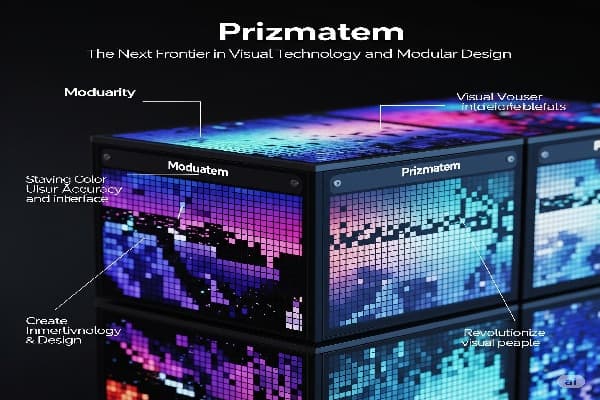Prizmatem: The Next Frontier in Visual Technology and Modular Design

In a world more dependent than ever on meaningful, immersive experiences, Prizmatem is quietly emerging as a revolutionary idea. It’s not just another tech buzzword—it’s a fresh take on how we use light, interactivity, and context in everything from augmented reality to smart homes. This guide breaks down what Prizmatem is, how it works, where it’s already making waves, and what the future might hold. Whether you’re a developer, designer, educator, or just curious, you’re in for a fascinating journey.
What Is Prizmatem?
At its simplest, Prizmatem combines “prism” (splitting and manipulating light) and “system” (layered, customizable frameworks). Think of it as a digital prism—transforming raw data, visuals, or educational modules into layered, dynamic experiences that feel alive and context-aware.
This is different from static apps or linear interfaces. Prizmatem responds to user behavior, environmental conditions, and content flow—making everything feel adaptive and intelligent.
Key Features of Prizmatem
-
Prismatic Modularity
Breaks down visuals or content into layers—color, context, UI—and allows you to manipulate each separately. -
Real-Time AI Rendering
Automatically adjusts light and interface elements based on conditions like device settings, user interactions, or ambient environment. -
Lifelike Color Fidelity
Inspired by optical systems like Oakley’s PRIZM lenses, it enhances contrast and clarity digitally. -
Eco-Friendly Tech
Uses advanced photonic materials that reduce power use—ideal for lighting, wearables, and AR gear. -
Developer-Friendly SDKs
Plug-and-play APIs and open-source tools for platforms like Unity, Unreal, or WebXR make it easy to integrate.
5 Innovative Use Cases for Prizmatem
1. AR/VR Experiences
Problem: Extended use of AR/VR can strain the eyes.
Solution: Prizmatem filters light in layers—adjusting contrast and color intensity dynamically.
Example: A meditation VR app shifts hues to match your breath or soundtrack, easing eye fatigue and deepening immersion.
2. UI Design That Feels Alive
No more jarring UI shifts. Prizmatem-powered interfaces subtly change color and tone based on your mood or time zone—so apps feel both stylish and intuitive.
3. EdTech Reimagined
Complex subjects get clarity through layered visualization. Imagine learning biology with interactive layers of skin, bones, and organs—all peeled away gently as you go.
4. Smart Home & Ambient Lighting
Prizmatem-enabled lights shift throughout the day—bright and focused in the morning, calming in the evening—supporting natural circadian rhythms and wellbeing.
5. Next-Level Creative Tools
Designers can manipulate translucent textures in real time. A Prizmatem plugin in Blender, for example, makes crystal-like models reflect ambient light naturally—no post-processing needed.
Also Read : 3d659.com Blog – Your Gateway to Smart Insights in 3D, Tech, and Lifestyle
Who’s Using Prizmatem Today?
-
Adobe Firefly: Adapts visual layers using light-based pixel rendering.
-
Meta Quest: Optimizes AR visuals through contrast layering.
-
Philips Hue: Compatible with smart light apps that adjust hues based on mood or schedule.
-
Unity VFX Graph: Offers real-time visual layering for 3D effects.
Why Prizmatem Works—The Science Behind It
Prizmatem draws from:
-
Photonics: Micro-prism optics separating light into component colors
-
Neuroscience: Color psychology and comfort-aware design
-
Computer Vision: Sensors tracking environment and user data
-
HCI (Human-Computer Interaction): Designing UX that adapts to people
-
Machine Learning: Predicting user needs and adjusting experiences instantly
Benefits You Can Feel
-
Deeper engagement through richer visuals
-
Less eye fatigue, even during long sessions
-
Faster development with modular tools
-
Improved performance on battery-powered devices
-
Better accessibility, accommodating vision or sensory differences
-
Premium appearance that feels intuitive, not gimmicky
Challenges to Consider
-
Hardware cost: Custom photonic materials can be expensive
-
GPU/AI needs: Real-time rendering requires capable devices
-
Growing tools: Open-source support is still emerging
-
Design balance: Overuse of effects can overwhelm users
That said, GPU and AI tech are advancing rapidly—and Prizmatem tools are starting to fill the gaps.
What’s Next for Prizmatem?
Imagine:
-
Smart glasses that overlay text and images directly onto your vision
-
Interactive hospital displays showing 3D anatomy with prism layers
-
Adaptive office lights that brighten during meetings and dim for relaxation
-
Mobile apps that ease blue-light strain at night using prism-inspired UIs
These aren’t sci-fi dreams—they’re on today’s innovation roadmap.
Compare: Prizmatem vs. Ordinary Design
| Feature | Prizmatem-Style Experience | Traditional Design |
|---|---|---|
| Visual Adaptability | Dynamic color, depth, and light control | Static palettes, manual adjustments |
| Development Approach | Modular, layer-based, reusable components | Linear, one-off builds |
| User Comfort | Reduces fatigue with subtle, AI-driven shifts | Can feel harsh under bright screens |
| Tech Requirements | Needs GPU/ML support, photonic materials | Standard interfaces work broadly |
| Customization | Personalized to user behavior and environment | One-size-fits-all designs |
Getting Started with Prizmatem
-
Interested in adding colored layers? Explore Unity or WebXR SDKs.
-
Experiment with responsive lighting in your next smart-home project.
-
Try prototyping with existing platforms like Firefly or Hue to grasp the user experience.
Final Thoughts
Prizmatem isn’t just a tech fad—it’s a thoughtful way to bring light, adaptability, and context into our digital and physical worlds. It’s the kind of tech that feels personal yet powerful, subtle yet transformative.
If you’re a developer, designer, educator, or maker, Prizmatem offers a fresh lens—a prism—through which we can rethink interaction, immersion, and illumination.
Want help bringing Prizmatem-style design into your next project? I’d love to brainstorm with you.



